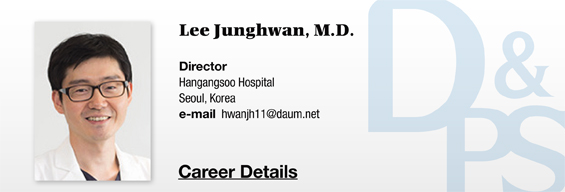
In 1995, Dierickx found that 77% of scars improved after 1.8 treatments with PDL9. PDL was also found to be effective in keloids. In 1996, Alster and McMeekin found that facial erythematous hypertrophic scar improved with 585nm PDL therapy.10 In 1998, they also reported that PDL used after CO2 laser de-epithelialization drastically improved the surface of non-erythematous, mild hypertrophic scars.11
Continuous wave CO2 laser was first introduced in 1978 by McBurney. It was used to remove tattoos and warts. From the 80s to 90s, laser ablation was popular in the US and the pulsed CO2 laser was often used to relieve photo-damaged skin in the 1990s. In 1999, Kaufmann reported that the Er:YAG laser had superior precision, efficacy and safety compared to CO2 laser. Kaufman found that the Er:YAG laser caused less downtime and erythema.12 However, most of the subsequent studies advised using caution with both ablative lasers as they were similar in efficacy13, as well as in the risk of edema, erythema, infection, pigmentary complications and hypertrophic scar.
Understanding selective photothermolysis is crucial to performing safe and effective laser scar removal. Selective photothermolyisis refers to laser’s action that incurs damage to only target tissues and leaves the surrounding tissues intact. Irradiating the laser with the right wavelength for selective absorption in target chromophores for the duration shorter than TRT results in selective thermal damage of target chromophores while leaving surrounding healthy tissues undamaged. 6, 12

Figure 3. Absorption curves of different wavelengths.
In 2004, Manstein proposed the concept of fractional photothermolysis which led to a rapid advancement in laser scar removal. Unlike continuous wave CO2 laser, fractional photothermolysis limits damage to the microthermal zone (MTZ) while promoting collagenesis and release of fibroblasts to accelerate reepithelization from the healthy surrounding tissues. This helps reduce the side effects and increase safety.
Fractional laser can be divided into ablative fractional resurfacing (AFR) and non-ablative fractional resurfacing (NAFR). NAFR is known to be superior compared to AFR in conditions such as mild to moderate acne scars, dyschromia, photo-induced wrinkles, poikiloderma of Civatte, melasma, hyperpigmentation, hypopigmentation, and granuloma annulare. AFR delivers heat energy through creating deeper columns in the skin than NAFR and is effective in scars and photoaging.15 Weiss reported that AFR therapy resulted in 26-50% improvement of pigment and texture and 38% improvement of volume in contracting scars.16
[Advertisement] Ultra Skin/Pastelle – Manufacturer: WONTECH(www.wtlaser.com)
-To be continued
References
8. Alster TS. Improvement of erythematous and hypertrophic scars by 585-nm fl ashlamp-pumped pulsed dye laser. Ann Plast Surg. 1994;32(2):186 – 90.
9. Dierickx C, Goldman MP, Fitzpatrick RE. Laser treatment of erythematous/hypertrophic and pigmented scars in 26 patients. Plast Reconstr Surg. 1995;95(1):84 – 90; discussion 91 – 2.
10. Alster TS, McMeekin TO. Improvement of facial acne scars by the 585 nm fl ashlamp-pumped pulse dye laser. J Am Acad Dermatol. 1996;35(1):79 – 81.
11. Alster TS, Lewis AB, Rosenbach A. Laser scar revision: Comparison of CO 2 laser vaporization with and without simultaneous pulse dye laser treatment. Dermatol Surg. 1998;24(12):1299 – 302.
12. Kauver ANB, Hruza GJ. Principles and practices in cutaneous laser surgery. Boca Raton, FL: Taylor and Francis Group; 2005. p. 12 – 29
13. Khatri KA, Victor R, Grevelink JP, Magro CM, Anderson RR. Comparison of erbium:YAG and carbon dioxide lasers in resurfacing of facial rhytides. Arch Dermatol. 1999;135: 391 – 7.
14. Manstein DD, Herron GS, Sink RK, Tanner H, Anderson RR. Fractional photothermolysis: a new concept for cutaneous remodeling using microscopic patterns of thermal injury. Lasers Surg Med. 2004;34(5):426-438.
15. Chrastil B, Glaich AS, Goldberg LH, Friedman PM. Second-generation 1,550-nm fractional photothermolysis for the treatment of acne scars. Dermatol Surg. 2008;34:1327 – 32.
16. Weiss ET, Chapas A, Brightman L, Hunzeker C, Hale EK, Karen JK, et al. Successful treatment of atrophic postoperative and traumatic scarring with carbon dioxide ablative fractional resurfacing: Quantitative volumetric scar improvement. Arch Dermatol. 2010;146(2):133 – 40.
17. Tierney EP, Kouba DJ, Hanke CW. Review of fractional photothermolysis: Treatment indications and effi cacy. Dermatol Surg. 2009;35:1445 – 61.
18. Khalil A. Khatri, Danielle L. Mahony & Melissa J. McCartney. Laser scar revision: review. J cosmetic and laser therapy.2011;13:54-62




















